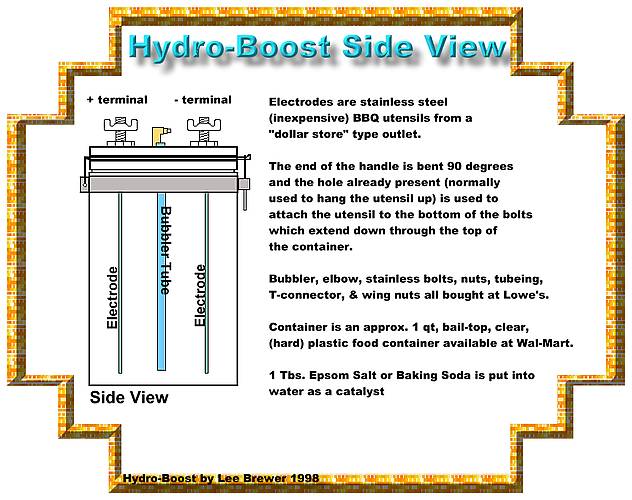Hydrogen & Oxygen - Hydrolysis for gas mileage boost
By Lee Brewer; posted July 22, 2008
View Original: Click to zoom, then click to magnify (864 x 684) 1732KB

|
Theory and construction I came up with this idea back in '98. I had a friend publish/market a book containing it. I see now that people sell this exact unit online for up to $1200.00! I am not sure if they or the oil Co'.s are more greedy. This unit should cost about 20.00 max to make. Why am I not selling it anymore? B/c I am sickened that someone (who is a victim of oil Co's as we all are) would take an idea like mine and make people pay so much for it - when it is so simple and inexpensive to make/use.. High amperage in water causes the Hydrogen and Oxygen making up the formula H2O to split. Using stainless steel BBQ utensils as electrodes; a hard, clear, plastic, bail-topped, approx 1 qt food storage container; 2 stainless steel bolts, 4 stainless nuts, two wing nuts, copper wire to attach terminals of battery to bolts, a plastic elbow connector that will allow gas to flow through, a plastic T-connector, and some air hose, the unit shown in these 3 pics is assembled. 1 TBS Epsom salt is added to container and container filled almost to top with water. Top installed; wires connected; and, preferably, a switch is installed such that you can turn off and on the unit from inside the car (I used an old light switch). Either this or out one of the terminals to a connection that is only hot when the car is on (suggestion - probe around the fuse box for one and connect the wire there). Drill holes in top of container lid to insert bolts, bubbler tube, and elbow connector. I used silicon sealer around them to make sure they were airtight. When the unit is closed, the rubber gasket seal which comes with the food container may or may not be airtight - use silicon sealer where needed to help the gasket - just remember you will be opening/refilling the unit. Cut air hose from PCV valve to carb./fuel injector unit. Insert the T-connector into the just-cut hose ends. Attach a hose to the free part of the T-connector and put the other end of this hose to the elbow on top of the Hydro-Boost unit. The vacuum produced in the engine will pull through this hose and cause a vacuum in the top of the Hydro-Boost. This top-vacuum will cause air to be pulled into the top of the bubbler tube, force it to travel up through the liquid, and then force it into the gas-impregnated area at the top of the inside of the Hydro-boost. This guarantees to gases are going in to the engine. Hydrogen and Oxygen are the two most flammable gases there are. They have to be burned when entering the engine - thereby supplying a boost to gas mileage. The only hampering thing I have encountered so far is what I assume to be the Oxygen sensor adjusting the car's system when it sense the increase of Oxygen gas. Experiment. I went from 200 miles per tank of gas to 400 miles per tank of gas. I used to empty/refill the unit each time i got gas. A rust colored sludge will be produced in the bottom of the container - I just washed it all out and put in fresh (tap) water and more catalyst. The water will get cloudy as it runs - but the system continues to work. The electrodes will eventually need replaced as they wear out . I installed mine by mounting a metal coffee can under the hood, wrapped a thin piece of foam rubber around the inside, and inserted the Hydro-boost. This got rid of vibration which might rub through the plastic and allowed for easy removal/cleaning/refilling. disclaimer - I never had trouble with it on 3 cars. However, b/c of the ridiculous day and age we live in I must protect myself saying you build / use this at your own risk. I accept no responsibilities for you reading/trying/building the Hydro-Boost unit. |